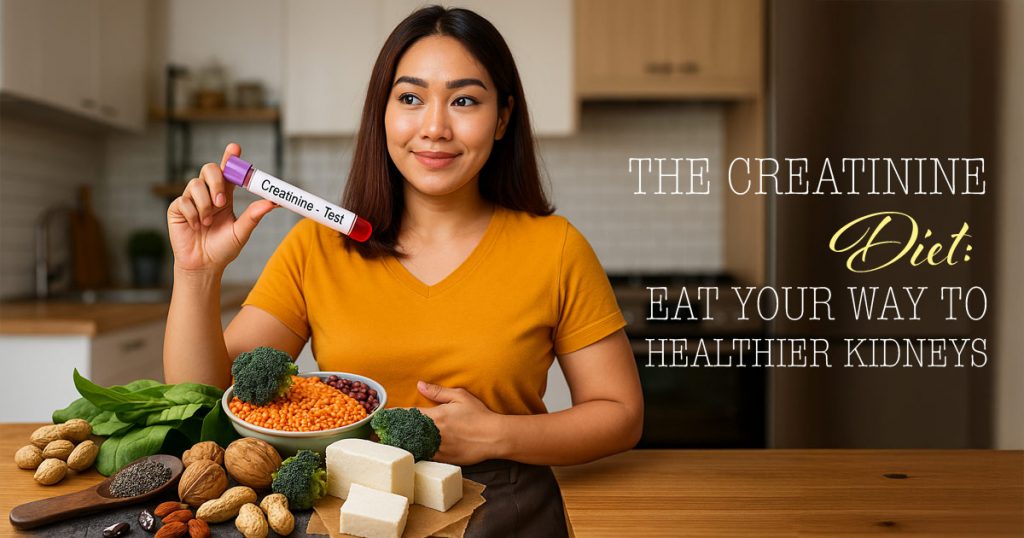Have you ever wondered about your kidney health? It’s a vital topic, especially when you consider that, according to the CDC, an estimated 1 in 7 adults in the United States may have Chronic Kidney Disease. A key indicator of kidney function is the level of creatinine in your blood.
Creatinine is a natural waste product from muscle wear and tear, and healthy kidneys are experts at filtering it out. When levels are high, it can be a sign your kidneys need a little support. The good news is that your diet can play a powerful role. This guide will explore how to reduce creatinine level by food, focusing on what to eat and what to limit for better kidney health.
The Best Foods to Lower Creatinine
When thinking about which food reduces creatinine level, the goal is to choose options that are easy on your kidneys and help your body function more efficiently. The focus should be on fresh, whole foods that are naturally low in protein, sodium, and potassium, while being rich in antioxidants and fiber. These creatinine lowering foods can make a real difference.
A great place to start is with a colorful variety of fruits and vegetables to reduce creatinine level. Here are some excellent choices:
List of Fruits to Reduce Creatinine Level
- Berries: Blueberries, cranberries, and strawberries are packed with antioxidants and vitamins that help reduce inflammation.
- Red Grapes: Rich in flavonoids, which have been shown to protect the kidneys.
- Apples: A fantastic source of pectin, a type of soluble fiber.
- Pineapple: Contains bromelain, an enzyme that can help reduce inflammation.
Vegetables to Reduce Creatinine Level
- Cucumber & Bell Peppers: These are high in water content and low in potassium, making them excellent for hydration and kidney health.
- Onions & Garlic: Great for flavoring food without adding sodium. They also have anti-inflammatory properties.
- Cauliflower & Cabbage: These cruciferous vegetables are low in potassium and rich in essential vitamins.
Additionally, incorporating fiber foods to lower creatinine is a smart strategy. Studies have shown that increased dietary fiber can help lower creatinine levels in people with chronic kidney disease. Foods like oats, barley, and the fruits and vegetables listed above are excellent sources.
What Food Should Be Avoided If Creatinine Is High?
Just as important as knowing what to eat to lower creatinine is understanding which foods can make the problem worse. Knowing what food should be avoided if creatinine is high? is a critical part of a kidney-friendly diet. Limiting or avoiding certain foods reduces the workload on your kidneys.
Here’s a look at which food increase creatinine level or put extra strain on your kidneys:
- Red Meat and High-Protein Foods: The digestion of red meat produces a significant amount of creatinine. Limiting red meat and even large portions of poultry can help manage your levels.
- High-Sodium Foods: Salt makes your body retain water and can raise your blood pressure, which is a major risk factor for kidney damage. Avoid processed foods, canned soups, fast food, and salty snacks.
- High-Phosphorus Foods: Damaged kidneys struggle to remove phosphorus. Foods like dairy products, nuts, and dark-colored sodas are high in phosphorus and should often be limited.
- High-Potassium Foods: While potassium is essential, too much can be harmful if your kidneys aren’t filtering properly. Foods like bananas, oranges, potatoes, and tomatoes may need to be consumed in moderation, depending on your specific condition.
- Creatine Supplements: Avoid any supplements containing creatine, as they will directly break down into creatinine in your body.
Natural Ways to Lower Creatinine Beyond Diet
Managing your diet is the cornerstone of a high creatinine diet. How to reduce creatinine level should involve a home remedy plan like other lifestyle habits . Learning how to lower creatinine naturally involves a holistic approach.
Here are some other natural ways to lower creatinine:
- Drink for Hydration: Drinking enough water helps your kidneys flush out creatinine and other toxins more effectively. Aim for clear or light-yellow urine as a sign of good hydration.
- Moderate Your Exercise: Intense exercise breaks down muscle faster, which temporarily increases creatinine. Opt for moderate activities like walking, yoga, or light cycling.
- Consider Herbal Teas: Some people find that teas like chamomile or nettle leaf, which have diuretic properties, can be helpful. However, always discuss this with your doctor first.
- Manage Blood Pressure and Blood Sugar: High blood pressure and diabetes are leading causes of kidney damage. Keeping them under control is crucial for long-term kidney health.
By combining these lifestyle tips with a mindful diet, you can discover what foods help lower creatinine levels and support your body’s overall wellness.
Your Journey to Wellness Starts with a Simple Choice
Taking control of your diet is one of the most empowering steps you can take for your health. While the information here provides a great starting point, my strongest recommendation is to always work with a healthcare professional or a registered dietitian. They can provide personalized advice based on your specific blood work and health needs.
A simple change, like swapping a salty snack for a crisp apple or a side of red meat for grilled vegetables, isn’t just a small adjustment—it’s an investment in your long-term health. Be patient with yourself, make small, sustainable changes, and you’ll be on the right path.

